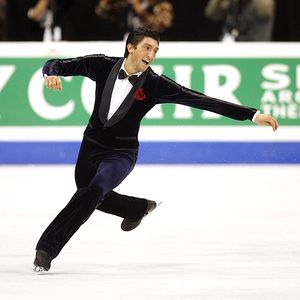
While the most exciting portions of figure skating routine (for some) are the jumps, these high-flying athletic moves are the ultimate feats of a skater’s ability. Jumps, in figure skating, come in two varieties, rotational and positional. Positional jumps are short jumps that display an artistic position in the air. The primary objective of rotational jumps is to rotate while airborne. In these jumps, the skater appears to spin in the air. Skaters’ routines are measured partly on rotational jumps. For a quad, skaters have to achieve maximum rotation. While skaters need to develop as much rotational energy as possible, it is important that they obtain the best possible rotational position during the airborne portion of a performance as well.
Dick Button landed the first triple in 1952. Kurt Browning of Canada landed the first quad in 1982. Today, the quad jumps have become required elements in the men’s program. Quad toe loops seem to be the most frequently attempted quad jumps. While many skaters credit Jozef Sabovchik of Slovakia with landing the first quad jump, in 1984, at the Winter Olympics. The first official quad was performed by Kurt Browning at the 1988 world championships. Suddenly the quad is the rage. How far will we go with those risky jumps? Do we want five six rotations in the air? Are we looking for as many revolutions until we run out of numerical prefixes? What is the limit of jumping possibilities? Is a quintuple toe loop or a quadruple Axel in our future?
The jump is called a quadruple toe loop, and it is performed by gliding backward on the right skate, planting the left toe pick, lifting off with an outside edge of the right skate, spinning four times and landing on the same outside edge of the right skate. Art, science, agility and strength have all been used in describing skaters. However, it takes a high degree of difficulty to achieve the quad. The key is to get the optimal combination of height and rotation. There are four key events for the quad. Toe-pick: the instant the toe pick is planted onto the ice; Take off: the last contact with the ice; Height: the top of the flight phase; Landing: the immediate contact with the ice. Obviously, the quad alone will not win a title; it's the total package, the artistry, the spins and the footwork. Obviously the focused should be on elements other than just the jumps.
A mistake in the quad costs dear while skaters can gain points on easier jumps. Doing a quad comes down to risk vs. reward in a judging system that puts emphasis on energy-sapping footwork and stiffly penalizes faulty jumps. The quadruple toe loop, is worth 9.8 points. The quad can come at a price. If you do it, you're a star. But if there is anything wrong with it -for instance, a fall, or it's under rotated, or too weak to do a combination after it, it's downgraded. There are very few skaters who can make a mistake on the quad and still land it. A negative grade of execution can cost up to three points. A triple Axel is worth 8.2 points. When it is done well, it can earn up to three bonus points. So why risk falling on a quad when you're more likely to land a clean triple Axel anyhow?
Rotational energy is the fuel that skaters work with, and they have to have energy to work with. The quad is an important jump. It's fun. It's interesting. It's beautiful when it's done right. While the quad is big news, I wonder if it will be some time before figure skaters are doing quintuple jumps. If you can do a quad well, by all means do it. But skating should never be about the jumps. It should be poetry on ice! No quad. While I agree that quad jumpers should be given more points, because of the tremendous risks involved, but I would rather be very pleased with the attention given to creativity and to the art we are so used to when it comes to skating.
The quad jump is a spectacular move. It is a neat and exciting. With the techniques and equipment currently used now, I think the athletes are pushing the envelope. I don't see a quint any time soon or a quad Axel. I do see the other more difficult quads --Lutz's and flips however-- being done soon as well as more consistent and higher quality jumps. To add a revolution may take a while (or maybe not) and potentially some new technique, training or equipment modifications to the sport. I imagine that with different technologies in boots, blades, along with different training techniques, strength-training, and perhaps costumes, it might be possible for skaters to land bigger jumps.
There are limits to what the human body can do and I wonder how close we are to them in the sport of figure skating. I long for the good ole 6.0 system. Weir has complained of the new system, saying such things as, “It gives you points for being able to chew on your shoes,“ Concerns for artistic expression has become secondary with the preoccupation of racking up points. Technical ability does not only pertain to jumps, but it includes spins, footwork, and a general flexibility. I just love to watch figure skating, and to witness the numerous feats of athleticism, skill, courage, endurance and passion.

Top Stories





